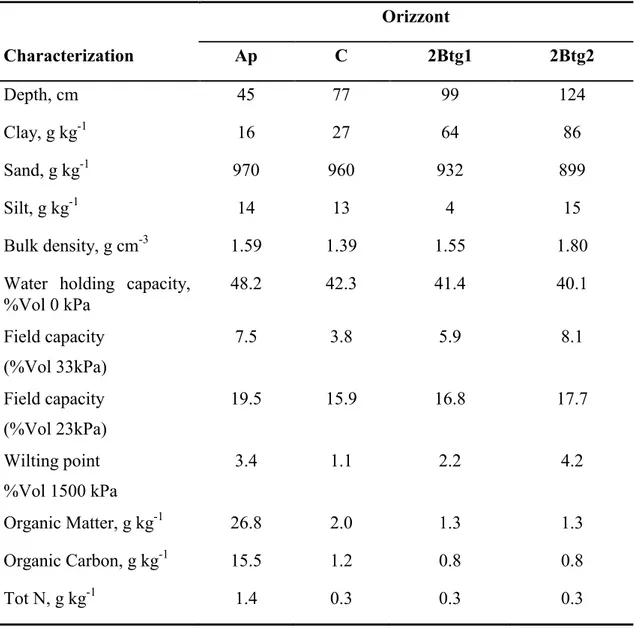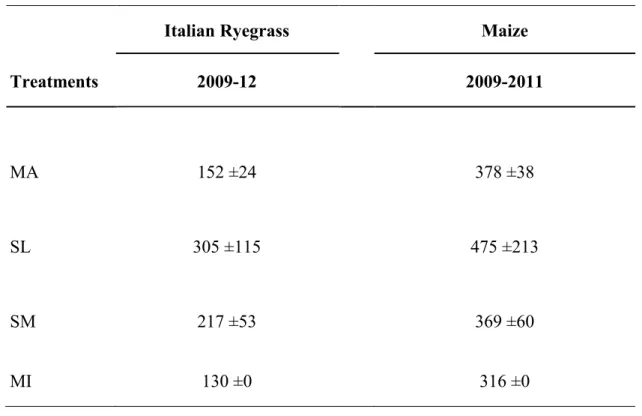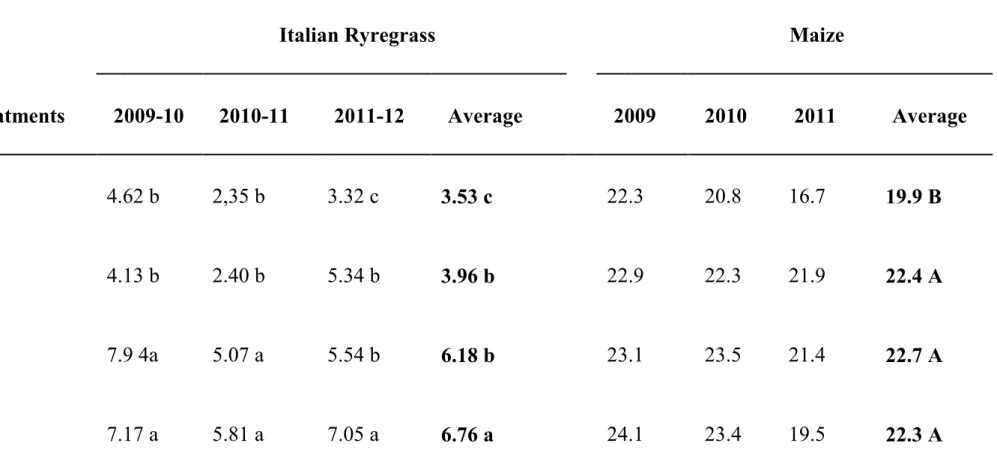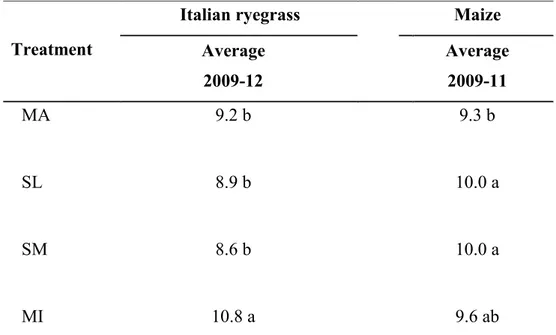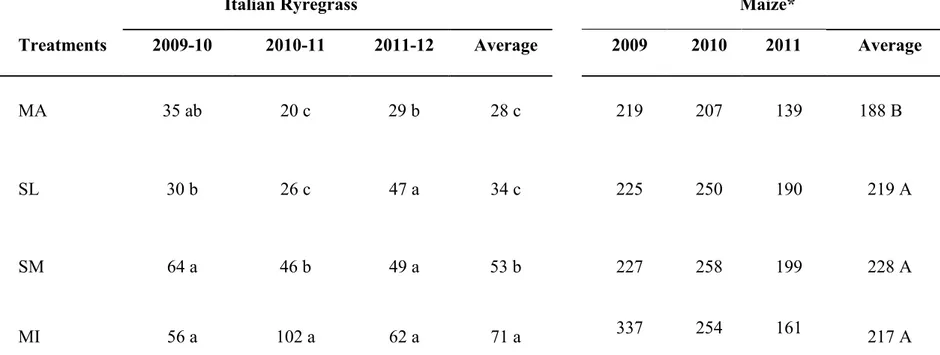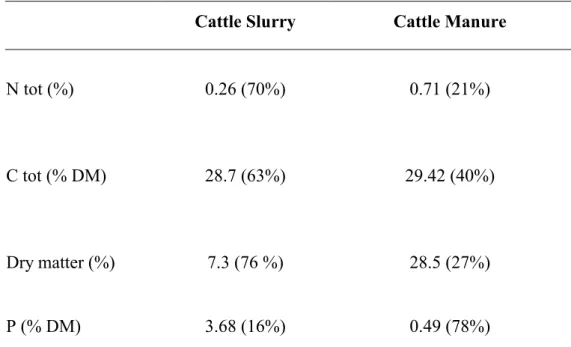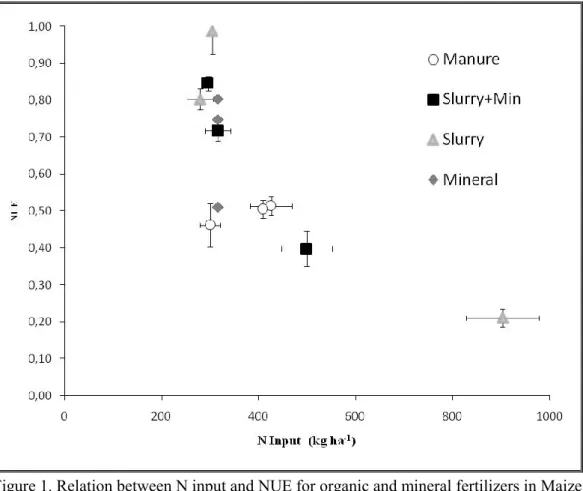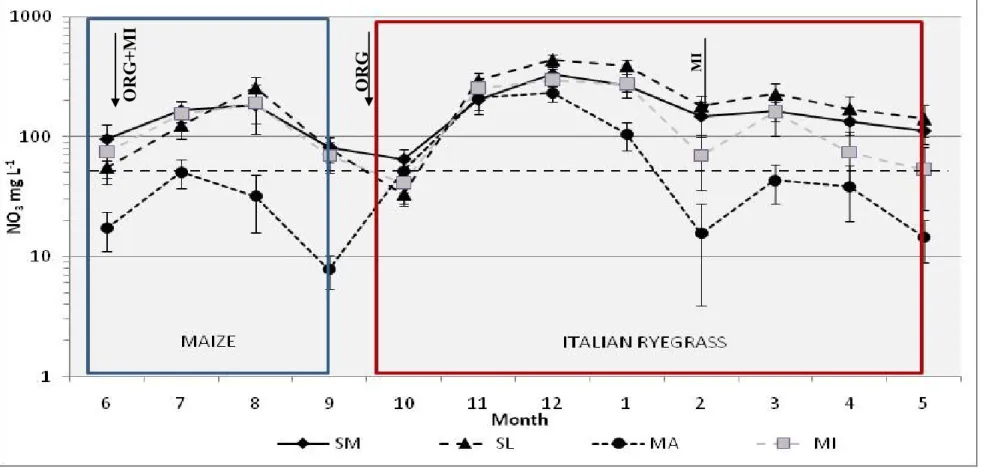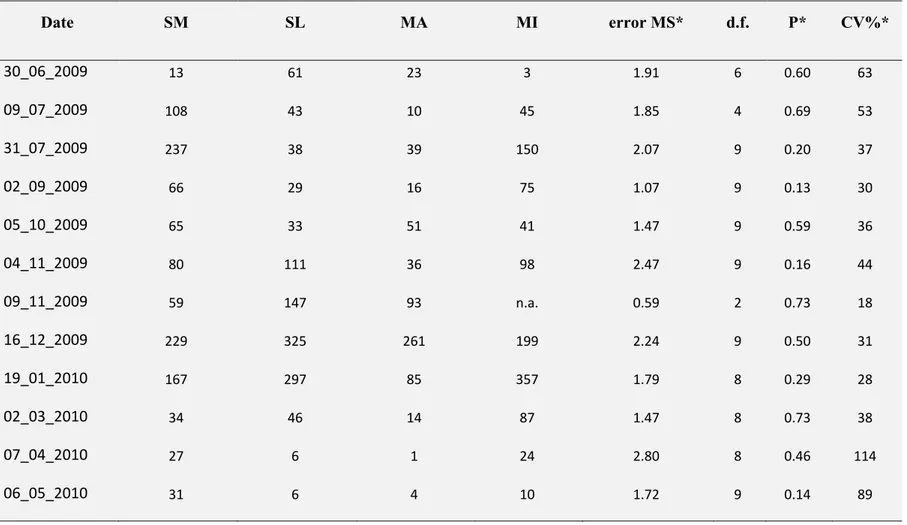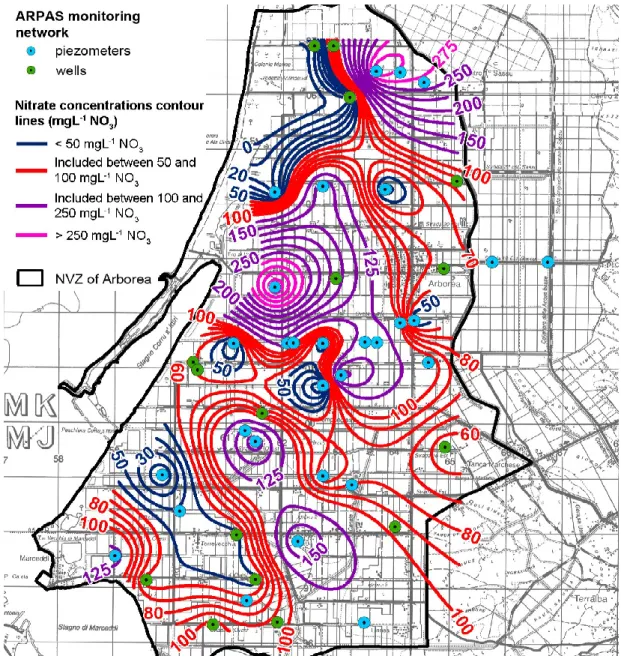UNIVERSITÀ DEGLI STUDI DI SASSARI SCUOLA DI DOTTORATO DI RICERCA
Scienze e Biotecnologie dei Sistemi Agrari e Forestali e delle Produzioni Alimentari
Indirizzo Produttività delle Piante Coltivate
Ciclo XXVI
SUSTAINABLE
MANAGEMENT
OF
NITROGEN
FERTILIZATION
IN
IRRIGATED
FORAGE
SYSTEMS
IN
NITRATE
VULNERABLE
ZONES
Dott.ssa Clara Ella Demurtas
Direttore della Scuola Prof.ssa Alba Pusino Referente di Indirizzo Prof.ssa Rosella Motzo Docente Guida Prof. Pier Paolo Roggero
Contents
Summary 4 Introduction 5 General hypothesis 9 Objectives 9 References 11Chapter I: Nitrogen use efficiency of fertilizer in intensive forage systems under
Mediterranean conditions. 17
Abstract 17
Introduction 17
Materials and Methods 20
Study site and experimental conditions 20
Experimental layout and crop management 20
Measurements 23
Dry matter yield, N content and uptake 23
Indicators of N use efficiency 24
Statistical analysis 24
Results 25
Ryegrass hay production 25
N content of the aboveground biomass N uptake 27
N use efficiency 28
Discussion 32
Ryegrass hay production 32
N content of the aboveground biomass N uptake 32
N use efficiency 30
Conclusions 33
References 36
Chapter II: Fertilization management and nitrate leaching in irrigated forage crops for
Mediterranean dairy farming systems. 40
Materials and Methods 42
Site and crop management 42
Water sampling and analysis 43
Water Percolation 44 Statistical analysis 44 Results 45 Nitrate concentration 45 Water percolation 46 Discussion 53
Nitrate concentration in water percolation 53
Conclusion 55
References 56
Chapter III: Assessment of the potential nitrate leaching from agricultural sources in a
Mediterranean NVZ 59
Abstract 59
Introduction 59
Materials and Methods 61
Survey site 61
Water balance 63
N balance and N surplus 64
Results 67
Water balance 67
Nitrogen balance and N surplus 67
Discussion 72
Conclusions 74
Attachment 76
References 77
Summary
The research was conducted in an intensive dairy farming Nitrate Vulnerable Zone (NVZ) under irrigated Mediterranean conditions focusing on the irrigated maize-Italian ryegrass cropping system. The aims of study were i) quantification of the cropping system nitrogen use efficiency (NUE) of organic fertilizers in relation to the prescriptions imposed by the Nitrate Directive (91/676/CEE), ii) assessment of the nitrate leaching dynamics under the maize-ryegrass cropping system in relation to contrasting fertilization systems, iii) assessment of the relations, at territorial scale, between N surplus and NO3 concentration in
groundwater.
Four fertilization systems were compared at field scale: slurry+mineral, slurry, farmyard manure and mineral at a target rate of 315+130 kg ha-1 N for maize and ryegrass respectively. Fertilization rates of organic fertilizers varied according to their variable N content. NUE of organic fertilizers was not significantly different from that of mineral for maize if N rates were near to target. Organic fertilizers had very low NUE for the ryegrass. The soil water nitrate concentration was very variable in time with minimum in spring and maximum in autumn-winter. At district area, the average N surplus was closely correlated with the N input.
The study provided sufficient evidence that N pollution of groundwater occurs in autumn-winter and that there are margins to increase the crop N use efficiency by reducing the actual N inputs without significant reduction of crop yield, but with increased costs for the disposal of effluents outside the NVZ.
Introduction
Until the 90s the objectives of the European Community and national policies have had as main objective the increase agricultural competitiveness, through the intensification of cropping systems, the modernization of the sector and the specialized company. This has resulted in a significant increase in the number of animals bred mainly in central and northern Europe, but not only, resulting in the development of the use of double-cropping maize-ryegrass especially in intensive systems of dairy cattle (Moreira, 1994). This cropping system has allowed important management options to increase the production of forage (Helsel and Wedin, 1981; Hughes, 1985) needed for animal feeding. These farming systems are characterized by keeping animals sheltered on barns equipped with concrete gratings, and they produce considerable amounts of slurry and manure widely available to any crop, but especially for maize (Zavattaro et al. 2012 a). In Italy dairy cattle livestock is represented by about 1.8 million animals (ISTAT, 2011) and maize is the most widespread cereal crop after wheat. The cultivated land increased by the end of 1980 until 2004, then, there was a decrease of about 400,000 hectares until 2009 but in recent years it has increased again (ISTAT, 2012), also in relation to the use of silage maize for the production of biogas. In fact the biogas plants increased from 273 to 521 in 2010-2011 (CRPA, 2010). Farmers often do not have enough land on which to dispose farm effluents, therefore this has led to the over-application of organic fertilizers in addition to the mineral fertilizers that are used to achieve high production of silage maize (20-25 t ha-1) and grass hay (7-10 t ha-1) (Giola et al., 2011; Trindate et al., 2008; Trindate et al., 1997 ). In this type of system, maintaining a high N use efficiency is crucial to obtain high yields and the nutritive value of forage (Neeteson, 2000; Aarts, 2003) but also to limit N losses in environment (Gourley et al., 2012; VandeHaar and St-Pierre, 2006; Fageria and Baligar, 2005) with a consequent impact on water resources underground (Monaghan et al, 2007; Schroder et al 2004; Trindade et al., 1997; Strebel et al., 1989).
According to Giles (2005) nitrogen (N) pollution is the third largest threat to our planet after biodiversity loss and climate change. Specifically, nitrogen losses from agriculture are considered a major cause of pollution of surface and groundwater water (Ten Berge, 2002 Behrendt et al., 2003; Delgado et al., 2008). The efficient N fertilization Nitrogen use
increasing crop yield and quality, and improving nitrogen use efficiency (NUE). The NUE defined as the ratio between the amount of fertilizer N applied and the amount of N removed with the harvest as reported by Brentrup and Palliere, 2010. Management strategies, adequate rate, appropriate source and timings of fertilizer application during crop growth cycle play an important role in reducing costs of production and environmental pollution (Abbasi et al., 2012; Fageria et al., 2006; Ruiz-Diaz and Sawyer, 2008). Such practices not only can increase yield but also contribute to the reduction of the cost of production and environmental pollution. Many studies have focused on split application of fertilizers as a way to reduce N losses and to improve NUE (Liu and Wiatrak, 2011; Sainz Rozas et al., 2004; Garrido-Lestache et al., 2005).
A nitrate directive (ND, 1991/676/CEE) was issued by the European Union in 1991 concerning the prevention of diffuse nitrate pollution of water bodies. The underlying objective of the ND is to reduce water pollution caused by nitrates from agricultural sources and to further prevent such pollution. The implementation mechanisms of the ND involve, among other things, the designation of nitrate-vulnerable zones (NVZs), comprising of areas that drain into polluted or vulnerable waters and which potentially contribute to nitrate pollution. Designation of NVZs is determined in relation to the achievement of a quality state in ground and surface water. A threshold was set for nitrate concentration in ground and surface water (50 mg L–1) to designate NVZs. Barnes et al. (2009) show that NVZ‟s in Europe account for 38% of the total agricultural area, on which there are various constraints including the regulation of the maximum rate of organic fertilizers to be applied on agricultural land (170 kg N ha-1 year-1).The ND doesn't distinguish the territorial aspect and the determinants of the problem, but more and more studies reported that the Mediterranean area showed that pedo-climatic contexts and socio-economic development are markedly different and distinct, compared to the northern and central Europe areas. In some studies it can be stated that it is not sufficient only to limit the amount of total N from animal manure because nitrate leaching depends on the speed and the strategy of application of all forms of N (Van Der Meer, 2001) from climate and soil conditions and management practices (Meisinger e Delgado, 2002; Havlin, 2004). Furthermore, the attention only on nitrogen inputs, as well as a uniform threshold, has been criticized because it doesn't take into account
2009 highlighted that the lack of objective success for NVZ designation suggests that nitrate pollution control strategies based on input management need to be rethought.
Following a scenario analysis and the definition of the potential environmental impact of dairy operations, Zavattaro et al. (2012 a) concluded that the expansion of a low-input grass-based farming type was the only solution that could significantly decrease N fluxes and achieve water quality targets. Moreover, the same authors stated that to define the scale of survey study more effective for understanding the system is highly complex: the choice of the scaling is critical because environmental processes are often non-linear and hence plot scale processes may not be useful to understand the catchment scale dynamics. When non-linearity and spatial heterogeneity are not taken into account, a loss of information and/or bias in the results may occur (Oenema and Heinen, 1999; Scoones and Toulmin, 1998). Therefore, scaling requires an understanding of the dynamics of the processes (Haila, 2002). According to Pelosi et al. (2010), a discrepancy in the spatial scale limits the effectiveness of agri-environmental policies and mitigation practices (Kleijn et al, 2004;. Concepción et al., 2008). Unfortunately, even after decades of studies, when mitigation of environmental impact of N use in agriculture is considered, the scaling issue is still unresolved (van Delden et al., 2011). Studies at the basin scale can allow to calculate the nitrogen surplus and quantify the importance of different input and output sources from the system to estimate the N losses (Leach et al., 2003). Since the 70s, the apparent N balance method was applied at different scales in France (Coppenet 1975), but this approach is applicable when sufficient information is available to reconstruct the flows in and out at farm, field or area scales. The method was designed to offer support to the farmer to calculate the optimal dose of nitrogen fertilizer to be distributed and was subsequently used to estimate the pollution potential of the crop (Simon and Le Corre, 1992). The apparent N balance method is currently applied at farm level to assess the potential for nitrate pollution of surface and ground water resources of different cropping or farming systems (Ventura et al., 2008; Simon, 1995). Balance sheets are widely used to study the flow of nutrients in ecosystems, such as agro-environmental indicators for the efficiency of use of nutrients, as well as tools in support of legislative policy (Oborn et al., 2003; Oenema et al., 2003). Several studies demonstrate that only holistic approaches can identify mitigation strategies that consider the whole farm
organization and sustainability and address both water and air quality protection (Zavattaro et al., 2012b; Collins et al. 2007). This involves the integration of different skills and levels of knowledge, both scientific and local, in order to contextualize effective actions. Nguyen et al. (2013) showed that the generation of „hybrid‟ knowledge (i.e. the integration of local and scientific knowledge), where integration of multiple views and methods in the framework of a carefully designed social learning process, can effectively contribute to better management of the nitrate issue. From the results of this study, we can argue that a prerequisite to trigger a new process towards the sustainable management of the N cycle in intensive dairy farming is the emergence of agreement on concerted actionsamong stakeholders.
In addition to the complexity of the nitrate issue, European countries, and in particular southern Europe, are exposed to climate change (CC) impacts on geochemical cycles, with increased risk of nutrient leaching, soil salinization, soil loss water erosion (AEA, 2007), and on the hydrologic cycle. This will expose the ecosystems and human communities to substantial changes in the availability and the quality water (as well as the reduction of crop productivity, increase the risk of desertification and neglect of marginal lands) with consequences also on human health (Townsend et al., 2003; Powlson et al., 2008). The CC can increase the risk of nitrate leaching unless preventive measures are taken. Warmer temperatures and higher CO2 concentrations may lead to higher demands for nitrogen
fertilizer (Olesen and Bindi, 2002; Olesen et al., 2007), but extreme weather events, such as heavy storms or droughts, will make fertilizer recommendations less reliable than under stable climate. Besides, a warmer climate may result in increased turnover of soil organic matter especially during winter (Olesen et al., 2004b), which may further increase the risk of nitrate leaching. Cost-efficient strategies to tighten the N cycle are therefore urgently needed. Such strategies should aim to minimize N availability when there is minimal root uptake and risk of percolation.
The areas affected by intensive cropping systems are the areas most prone to this type of vulnerability and risk. Therefore, in order to identify nitrogen fertilization management options applicable and sustainable in irrigated forage systems in Nitrate Vulnerable Zones is necessary.
General hypothesis
The identification of sustainable options for efficient nitrogen use and nitrate pollution mitigation in NVZ require an holistic approach, i.e. considering the agronomic, ecological and social dimensions as intertwined. In this research, new scientific knowledge was developed through a co-researching approach with stakeholders since the design of the experiments. A field scale experiment and a district scale survey were the core business of this research approach aiming to the deconstruction of the nitrate issue and the identification of new options for a more sustainable use of organic fertilizers. The data emerging from field experiments and surveys reported in this thesis were part of a wider process involving stakeholders in a learning process that led to the definition of the treatments to be compared in the field experiment and the integration of scientific and lay knowledge in the interpretation of results (Nguyen et al., 2013). This thesis reports only the results from the field experiment and territorial survey and related interpretations given by the researchers.
Objectives
The aim of the research was to collect data useful for the design of sustainable cropping systems in areas vulnerable to nitrate pollution in the context of intensive irrigated Mediterranean cropping systems, through the quantification of the nitrogen use efficiency of organic fertilizers and taking into account the specifications imposed by Nitrates Directive (91/676/CEE). The potential impact of nitrate leaching of an intensive cropping system is particularly relevant in areas where intensive dairy farming is practiced and excess farm waste is available for N fertilization.
The experimental research was framed in the context of international literature with regard to relations between agricultural activity and environmental quality with specific reference to the processes that control the nitrogen cycle in agro ecosystems. The study has been conducted at two different scales of investigation in a dairy farming context under Mediterranean conditions in which 80% of the agricultural area is occupied by a double cropping of maize and Italian ryegrass:
1. field scale: to evaluate the influence of the fertilization system on crop yield, nitrogen use efficiency of fertilizer and nitrate leaching potential, in order to support decisions on sustainable management strategies to be adopted;
2. territorial scale: to quantify the field gate N surplus as proxy indicator of the leaching potential of nitrate leaching in relation to the actual groundwater pollution.
The thesis was divided into three chapters, that were designed as independent papers that are intended to be submitted to a peer reviewed international journal.
I. The first chapter of the thesis is focused on the assessment of the cropping system N use efficiency of different fertilization systems in intensive forage systems for dairy cattle, in order to test if the ND prescriptions are consistent to the objective of maximizing NUE and minimizing nitrate pollution under Mediterranean conditions. II. The second chapter is focused on the assessment of the nitrate leaching dynamics
under the maize-ryegrass cropping system, in relation to contrasting fertilization systems.
III. The third chapter is focused on the assessment of the field gate Nitrogen surplus as an indirect estimator of the nitrate leaching potential at district scale, determinate through apparent N balance in the context of the ryegrass-maize cropping system.
References
Aaets H.F.M., 2003. Strategies to meet requirements of the EU-nitrate directive on intensive dairy farms. Proceedings No. 518, International Fertilizer Society, York, UK, pp. 1-27. London. Fertilizer Society.
AEA Energy &Enviroment and Universidad de Politécnica de Madrid (2007), Adaptation toc limate change in the agricultural sector, AEA/ed05334/ Issue 1 Report to European Commission Directorate- General for Agriculture and Rural Development, Oxford;
Abbasi Kaleem M, Tahir M.M., Rahim N.2012. Effect of N fertilizer source and timing on yield and N use efficiency of rainfed maize (Zea mays L.) in Kashmir–Pakistan. Geoderma 195–196, pp 87–93.
Behrendt, H., et al., 2003. Nutrient Emissions into River Basins of Germany on the Basis of a Harmonized Procedure. UBA-Texte 82. Umweltbundesamt, Berlin.
Collin K., Ison R., Editorial: living with environmental change; adaptation as social learning. Enviromental Policy and Governance, 19 (6): 351-357;
Coppenet, M., 1975. Bilan des elements fertilisants sueles exploitations d'élevage. Fourrages, 2, 119-132. CERcm PABA, F., 1974.
Concepción, E.D., Díaz, M., Baquero, R.A., 2008. Effects of landscape complexity on the ecological effectiveness of agri-environment schemes. Landscape Ecology 23, 135–148. Delgado, J.A., et al., 2008. An index approach to assess nitrogen losses to the environment. Ecol. Eng. 32, 108e120.
Fageria N.K.,. Baligar V.C, 2005. Enhancing Nitrogen Use Efficiency in Crop Plants. Advances in Agronomy, 88, pp 97-185.
Garrido-Lestache, E., López-Bellido, R.J., López-Bellido, L., 2005. Durum wheat quality under Mediterranean conditions as affected by N rate, timing and splitting, N form and S fertilization. European Journal of Agronomy 23, 265–278.
Giles, J., 2005. Nitrogen study fertilizes fears of pollution. Nature 433 (February),791, doi:10.1038/433791a.
Giola et al., 2012. Impact of manure and slurry applications on soil nitrate in a maize– triticale rotation: Field study and long term simulation analysis. European Journal of Agronomy, 38: 43-53.
Gourleya Cameron. J.P., Aaronsa Sharon R., Powellb J. Mark, 2012. Nitrogen use efficiency and manure management practices in contrasting dairy production systems. Agriculture, Ecosystems and Environment 147, 73– 81.
Haila, Y., 2002. Scaling environmental issues: problems and paradoxes. Landscape and Urban Planning 61, 59–69.
Havlin, J., 2004. Impact of management systems on fertilizer nitrogen use efficiency. In: Agriculture and the Nitrogen Cycle, vol. 65., pp. 167-178.
Helsel Z.R. and Wedin W.F. (1981) Harvested dry matter from single- and double-cropping systems. Agronomy Journal, 73, 895–900.
Hughes K.A. (1985) Maize ⁄ oats forage rotation under three cultivation systems, 1978–83. 1. Agronomy and yield. New Zealand Journal of Agricultural Research, 28, pp 201–207. ISTAT (Istituto Nazionale di Statistica), 2012. V Censimento nazionale dell‟agricoltura. Dataset available online at www.istat.it (verified 26/03/2010).
ISTAT (Istituto Nazionale di Statistica), 2011. V Censimento nazionale dell‟agricoltura. Dataset available online at www.istat.it (verified 26/03/2010).
Kleijn, D., Berendse, F., Smit, R., Gilissen, N., Smit, J., Brak, B., Groeneveld, R., 2004. Ecological effectiveness of agri-environment schemes in different agricultural landscapes in the Netherlands. Conservation Biology 18, 775–786.
Leach, K.A., et al., 2003. Nitrogen balances over seven years on a mixed farm in the Cotswolds. In: Hatch, D.J.,Chadwick, D.R., Jarvis, S.C., Roker, J.A. (Eds.), Controlling Nitrogen Flows and Losses.Wageningen Academic Publishers,Wageningen: 39–46.
Liu, K., Wiatrak, P., 2011. Corn production and plant characteristics response to N fertilization management in dry-land conventional tillage system. International Journal of Plant Production 5, 405–416.
Moreira N., 1994. Situação e perspectivasda produçãoforrageira intensiva no Entre Douro e Minho. (Characterization and future perspective of the intensive forage production system of NW Portugal). Pastagens e forragens, 15, 31-40.
Meisinger, J.J., Delgado, J.A., 2002. Principles for managing nitrogen leaching. J. Soil Water Conserv. 57 (6), 485-498.
Monaghan R.M., Wilcock R.J., Smith L.C., Tikkisetty B., Thorrold B.S., Costall D., 2007. Linkages between land management activities and water quality in an intensively farmed catchment in southern New Zealand. Agriculture, Ecosystems and Environment 118, pp 211–222.
Neeteson J.J., 2000. Nitrogen and phosphorus management on Dutch dairy farms: legislation and strategies employed to meet the regulations. Biology and fertility of soli, 30, 566-572. Nguyen T.P.L., Seddaiu G., Roggero P.P., 2013. Hybrid knowledge for understanding complex agri-environmental issues: nitrate pollution in Italy. International Journal of Agricultural Sustainability. http://dx.doi.org/10.1080/14735903.2013.825995.
Oborn, I., Edwards, A.C., Witter, E., Oenema, O., Ivarsson, K., Withers, P.J.A., Nilsson, S.I., Richert Stinzing, A., 2003. Element balances as a tool for sustainable nutrient management: a critical appraisal of their merits and limitations within an agronomic and environmental context. Eur. J. Agron. 20, 211–225.
Oenema, O., Kros, H., de Vries,W., 2003. Approaches and uncertainties in nutrients budgets:implications for nutrientmanagement and environmental policies. Eur. J. Agron. 20, 3–16.
Oenema, O., Heinen, M., 1999. Uncertainties in nutrient budgets due to biases and Oxon, UK, pp. 75–97.
Olesen, J.E., Bindi, M., 2002. Consequences of climate change for European agricultural productivity, land use and policy. Eur. J. Agron. 16, 239–262.Pelosi, C., Goulard, M., Balent, G., 2010. The spatial scale mismatch between ecological processes and agricultural management: do difficulties come from underlying theoretical frameworks? Agriculture, Ecosystems and Environment 139, 455–462.
Olesen, J.E., Rubæk, G., Heidmann, T., Hansen, S., Børgesen, C.D., 2004b. Effect of climate change on greenhouse gas emission from arable crop rotations. Nutr. Cycl. Agroecosyst. 70, 147–160.
Olesen, J.E., Carter, T.R., Diaz-Ambrona, C.H., Fronzek, S., Heidmann, T., Hickler, T., Holt, T., Minguez, M.I., Morales, P., Palutikof, J., Quemada, M., Ruiz-Ramos, M., Rubæk, G., Sau, F., Smith, B., Sykes, M., 2007. Uncertainties in projected impacts of climate change on European agriculture and ecosystems based on scenarios from regional climate models. Climatic Change 81 (Suppl. 1), 123–143.
Powlson, D.S., Addisott, T.M., Benjamin, N., Cassman, K.G., De Kok, T.M., Van Grinsven, H., L'hirondel, J.L., Avery, A.A., Van Kessel, C., 2008. When does nitrate become a risk for humans? J. Environ. Qual. 37, 291e295
Ruiz-Diaz, D.A., Sawyer, J.E., 2008. Plant available nitrogen from poultry manure as affected by time of application. Agronomy Journal 100, 1318–1326.
Simon J.C., 1995. Les exploitations herbagères de Basse-Normandie et l‟environnement, APEX, 50.
Simon J.C., Le Corre L., 1992. Le bilan apparent de l‟azote à l‟echelle de l‟exploitation agricole: metodologie, exples de resultats. Fourrages 129, 79-24.
Sainz Rozas, H.R., Echeverría, H.E., Barbieri, P.A., 2004. Nitrogen balance as affected by application time and nitrogen fertilizer rate in irrigated no-tillage maize. Agronomy Journal 96, 1622–1631.
Schröder, J.J., Scholefield, D., Cabral, F., Hofman, G., 2004. The effects of nutrient losses from agriculture on ground and surface water quality: the position of science in developing indicators for regulation. Environ. Sci. Policy 7, 15– 23.
Scoones, I., Toulmin, C., 1998. Soil nutrient balances: what use for policy? Agriculture, Ecosystems and Environment 71, 255–267.
Ten Berge, H.F.M., 2002. A Review of Potential Indicators for Nitrate Loss from Cropping and Farming Systems in The Netherlands. Plant Research International B.V, Wageningen, The Netherlands, 168 pp.
Trindade, H., Coutinho J., Jarvis J., and Moreira N, 2008. Effects of different rates and timing of application of nitrogen as slurry and mineral fertilizer on yield of herbage and nitrate-leaching potential of a maize ⁄ Italian ryegrass cropping system in north-west Portugal. Grass and forage Science, 64, 2-11.
Trindade, H., Coutinho J., Van Beusichem M.L., Scholefield d., and Moreira N., 1997. Nitrate leaching from sandy loam soil under a double-cropping forage system estimate from suction-probe. Grass and forage, 64, 2-11.
Townsend, A.R., Howarth, R.W., Bazzaz, F.A., Booth, M.S., Cleveland, C.C., Collinge, S.K., Dobson, A.P., Epstein, P.R., Holland, E.A., Keeney, D.R., Mallin, M.A., Rogers, C. A., Wayne, P., Wolfe, A.H., 2003. Human health effects of a changing global nitrogen cycle. Front. Ecol. Environ. 1, pp 240-246.
Worrall F., Spencer E., Burt T.P., 2009. The effectiveness of nitrate vulnerable zones for limiting surface water nitrate concentrations. Journal of Hydrology 370, pp 21–28
VandeHaar, M.J., St-Pierre, N., 2006. Major advances in nutrition: relevance to the sustainability of the dairy industry. J. Dairy Sci. 89, 1280–1291.
Van Der Meer H.G. (2001). Grassland and the environment. In: Jarvis S.C. (ed.) Progress in grassland science: achievements and opportunities, Proceedings of an IGER Research Colloquium, North Wyke, Devon, UK, pp. 53–67. Aberystwyth, UIK: IGER.
van Delden, H., van Vliet, J., Rutledge, D.T., Kirkby, M.J., 2011. Comparison of scale and scaling issues in integrated land-use models for policy support. Agriculture, Ecosystems and Environment 142, 18–28.
Ventura M, Scandellaria F., Ventura F., Guzzon B., Rossi Pisa P., Tagliavini M., 2008. Nitrogen balance and losses through drainage waters in an agricultural watershed of the Po Valley (Italy).Europ. J. Agronomy 29: 108– 115.
Zavattaro L., Grignani C., Acutis M., Rochette P., 2012a. Preface: “Mitigation of environmental impacts of nitrogen use in agriculture”. Agriculture, Ecosystems and Environment 147:1– 3
Zavattaro L, Monaco S., Sacco D., Grignani C., 2012 b. Options to reduce N loss from maize in intensive cropping systems in Northern Italy. Agriculture, Ecosystems and environment 147,pp 24– 35.
Chapter 1
Nitrogen use efficiency of fertilizer in
intensive forage systems under Mediterranean conditions
Abstract
Agricultural sustainability relies on Nitrogen Use Efficiency (NUE) where efficient N fertilization, soil and appropriate crop practices are among the most important management strategies for increasing crop yield and water quality either surface or groundwater. The experiment was conducted between June 2009 and September 2011 in a private farm. It was evaluated the effect of different types of N fertilization (cattle slurry, cattle manure, mineral and slurry plus mineral) on the DM yield of herbage and N use efficiency in intensive double-cropping forage systems for dairy cattle in Nitrate Vulnerable Zones (NVZs) in Mediterranean environment. The results of the field scale showed that in maize in the environmental conditions considered, the organic fertilization can achieve levels of NUE comparable to or slightly lower than those of mineral fertilizer. The Italian Ryegrass is exposed to massive leaching if fertilized before seeding and it showed a low efficiency of organic fertilizers.
Keywords: Nitrogen fertilization, Silage maize, Italian ryegrass, intensive dairy farming, Nitrate Vulnerable Zones, dairy cattle effluents.
Introduction
The Europe Union (EU) governmental policies of last 20 years about livestock farming, have contributed to increase the number of animals bred, in particular in dairy farms. The EU is a major player on world markets for most dairy goods and produces the largest single share of the global market. Dairying is one of the most profitable sectors of EU agriculture in particular in Germany, UK, France, Netherlands and North Italy.
However, the high number of livestock has led mainly to the production of large amounts of cattle waste , available to any crop. Farmers often do not have enough land on which to dispose the waste products in the farm, therefore, this has led to the over-application of these organic fertilizers in addition to those of synthesis.
Excessive N feeding in this system can decrease the Nitrogen Use Efficiency (NUE) and this is crucial to maintain high yields, the nutritive value of forage necessary for animal feed (Neeteson, 2000; Aarts, 2003), to reduce production costs and to limit N losses in the environment (Gourley et al., 2012; VandeHaar and St-Pierre, 2006; Fageria and Baligar, 2005) with a consequent impact on underground water resources (Delgado et al., 2008; Monaghan et al, 2007; Schröder et al 2004; Trindade et al., 1997; Strebel et al., 1989). Moreover, the increase of fertilizer and feed costs, the product prices reduction and the implementing regulations environmental pollution reduction have created new pressures to improve nutrient elements use in agricultural production.
In fact, the EU issued the Nitrates Directive (ND) (91/676/CEE), with the objective of reducing water pollution caused or induced by nitrates and to identify the Nitrate Vulnerable Zones (NVZ) (CE, 1991). Barnes et al., 2009 showed that the NVZ in Europe account for 38% of the total agricultural area, on which there are various constraints including the regulation of organic fertilizers (170 kg N ha-1 applied to agricultural land each year).
Agronomic management practices on the use of organic fertilizers may transform the target from a waste to a resource product.To improve N efficiency in agriculture, N management strategies that take into consideration the fertilizer improvement under soil and crop management practices, the application of adequate N doses and, the source and timing of fertilizer application during the crops growth cycle play an important role (Abbasi et al., 2012; Nevens and Reheul, 2005; Borin et al., 1997). Split application of N fertilizer in different phenological stages are often recommended to improve NUE, increase yields (Sainz Rozas et al., 2004; Schröder, 1999; Dilz et al., 1982) and reduce the loss of N. However, there are other studies where it‟s showed that split application of N fertilizer to different crops did not affect their performance and productivity (Garrido-Lestache et al., 2005; Zebarth et al., 2004). Abbasi et al., 2012 reported NUE of maize grown under different N fertilizer sources varied with both N sources and split application. Other studies
reported that split application of N fertilizer to different crops did not affect their performance and productivity (Liu and Wiatrak , 2011; Garrido-Lestache et al., 2005). The form or the source of added N plays an important role in regulating N transformations, changing N loss patterns and influencing NUE (Ladha et al., 2005). However the effect of N
not been reported extensively. Van Groeniger et al. (2004) showed a lower NUE when using slurry than with mineral fertilizers on silage maize. Ryegrass showed a higher NUE when the N fertilization takes place as coverage (rielaborated data Trindade et al., 2008). Powell et al. (2010) and Aarts et al., 2000 denoted that manure/fertilizer-NUE varies from 16% to 77% and is very site-specific on dairy farms due to high dependence on climate, crops/pasture-soil and management variables. Further information about the environmental effects and management options for agricultural use of organic residues in Mediterranean areas are required.
We hypothesized that under Mediterranean conditions, the NUE of cattle effluents used to fertilize a double cropping system based on grasses with high N uptake all year round can be of the same magnitude of that of mineral fertilizers at similar rates of total distributed nitrogen. We also hypothesised that the characteristics of the effluents (e.g. slurry or farmyard manure) would influence NUE. This may have implications on the implementation of policies to mitigate nitrate leaching in nitrate vulnerable zones.
The aim of the research was to evaluate the effect of different types of N fertilization on the DM yield of herbage and N use efficiency in intensive double-cropping forage systems for dairy cattle in NVZ in Mediterranean environment. This in order to support and help farmers decisions on possible strategies management to adopt. In particular for recycle the different sources of farm available N and hence minimize off-farm mineral N fertilizer. The experiment was designed in a way to assess the influence of fertilization using cattle manure, cattle slurry, cattle slurry plus mineral-N and only mineral-N, on herbage dry matter , N uptake by the crop and NUE.
Materials and methods
Study site and experimental conditions
The case study is located in Arborea (Province of Oristano, Sardinia, Italy; 39° 46‟ N; 8° 37‟ E), that was improved and reclaimed in the 1930ies. The experiment was conducted between June 2009 and September 2011 in a private farm located inside the NVZ. The area is characterized by Mediterranean climate with the rainy period that occurs during autumn. Total average annual precipitation is 600 mm. The annual average temperature is 17° C, the coldest month is January with average around 10°C, while the warmer is August with about 24° C. The soil is sandy (>90% sand) and according to Soils Classification Systems of United Sates Department of Agriculture (USDA) classification (2006), it is Psammentic Palexeralfs. Soil physical-chemical properties measured at the beginning are reported in Table 1.
Experimental layout and crop management
The experiment was done in a 3 ha field (100 x 300 m2). The crop rotation was based on the double–cropping forage system with maize silage (Zea mais L.) from June to September and Italian ryegrass (Lolium multiflorum Lam.) from October to May. This cropping system represents over 80% of the irrigated land in the case study area. Four fertilizer sources were compared at the same doses of N (316 and 130 kg N ha-1 for maize and ryegrass respectively), set on the basis of the N fertilization prescriptions for NVZ and on the crop N requirements and in accordance with local farmers:
i) MA= manure (mature cattle farmyard manure applied before sowing with a conventional spreader and followed by rotary tillage);
ii) SL= slurry (cattle slurry applied before sowing with a conventional spreader and followed by rotary tillage);
iii) MI= mineral (mineral fertilizer (ENTEC 26®) applied at the end of tillering for ryegrass );
Table 1 Main soil proprieties at the beginning of the experiment (2009) Orizzont Characterization Ap C 2Btg1 2Btg2 Depth, cm 45 77 99 124 Clay, g kg-1 16 27 64 86 Sand, g kg-1 970 960 932 899 Silt, g kg-1 14 13 4 15 Bulk density, g cm-3 1.59 1.39 1.55 1.80
Water holding capacity, %Vol 0 kPa 48.2 42.3 41.4 40.1 Field capacity (%Vol 33kPa) 7.5 3.8 5.9 8.1 Field capacity (%Vol 23kPa) 19.5 15.9 16.8 17.7 Wilting point %Vol 1500 kPa 3.4 1.1 2.2 4.2 Organic Matter, g kg-1 26.8 2.0 1.3 1.3 Organic Carbon, g kg-1 15.5 1.2 0.8 0.8 Tot N, g kg-1 1.4 0.3 0.3 0.3
iv) SM= control (slurry+mineral, i.e. slurry as above but at a target rate of 100 and 70 kg ha-1 N for maize and ryegrass respectively, and mineral fertilizer (ENTEC 26®) at a rate of 216 and 60 kg ha-1 N applied at maize emergence or the end of ryegrass tillering respectively.
The experimental design was a 4x4 latin square design with a plot size of 12x60 m2. A mixture of four varieties and hybrids of Italian ryegrass (Lolium multiflorum Lam. cv Meritra, Ivan, Littorio and Mowester) was sown during the last ten days of October and organic fertilizer, harrowing and milling were applicated every year. The mineral fertilizer
was applied at half February. Auxiliary irrigation was provided to ryegrass when necessary to minimize crop water stress. Ryegrass hay was harvested in mid-May at early earing stage. Hybrid maize (Zea mays L.), cultivar Calcio (FAO 700), was sown during the first ten days of June and it was harvested between the 15th and the 20th of September at the dough stage (target of 33% DM for the whole plant). The sprinkle irrigation started in June until early August. Maize was treated with pre-emergence herbicides (Lumax®). Seedbed was prepared using a rotavator, ripper and harrow, while the harvesting was conducted during mid to late May at the earing stage. The silage maize and Italian-ryegrass were underwent the same crop management for each year and used the same hybrid or mixture respectively. All agro-techniques were applied using business-as-usual machinery and modalities. The rate of organic fertilizers were supplied considering a N content of the organic fertilizers derived from previous analyses (Table 2). However actual rates were monitored by sampling the fertilizers spread on the field and analyzing it for the total and mineral N composition. The time of application of organic fertilizers is constrained by the on-farm available storage volume and NVZ prescriptions that forbid applications from November to 15 February to prevent leaching. A slurry sample per plot was collected from the tank before spreading it in the field. A total of 37 slurry samples were collected, frozen and stored for analysis of ammonium, total N and dry matter. Cattle manure, which is stored for five months before spreading, was collected before application. A total of 39 samples was collected for physical and chemical analyses. The mixture has been incorporated during day by ploughing to minimize the volatilization as ammonia. The N supplied to the plots (Table 2) was calculated from the amount of fertilizer distributed and the nutrient concentration of the fertilizer.
Table 2 N Input from organic and mineral fertilizes (average ± std error) of Maize and Italian Ryegrass from 2009-2012 (MA= Cattle Manure; SL= Cattle Slurry; SM= Cattle Slurry+ Mineral; MI=Mineral).
Italian Ryegrass Maize
Treatments 2009-12 2009-2011 MA 152 ±24 378 ±38 SL 305 ±115 475 ±213 SM 217 ±53 369 ±60 MI 130 ±0 316 ±0 Measurements
Dry matter yield, N content and uptake
Crop yield, aboveground biomass at harvest and N removal were measured every year. The aboveground maize biomass production at harvest was assessed by sampling 1 kg fresh weight that was immediately cooled in plastic bags and hence dried in a forced-air oven at 65°C for 72 h to determine DM weight. The aboveground biomass production of Italian ryegrass was measured on sample areas of 1 m2 per plot by cutting the grass with grass shears. After the sample collection, the entire plots were harvested using farm machinery and these products (fresh maize or ryegrass hay) were weighted immediately using electronic weighing cells positioned in a flat place under the tractor cart were the biomass was accumulated. The crop nutrient uptake was measured on the basis of the N content determined on samples through Kjeldahl method. Both measures were determined annually.
Indicators of N use efficiency
The N use efficiency of crops in the system were estimated as the amount of N removal by the harvested yield (N removal) divided by the total actual amount of fertilizer N supplied in each crop phase added to the estimated atmospheric N deposition:
NUE = Nremoval / (Nfertilizer + N deposition)
N deposition in the area was estimated as 2.4 kg N ha-1 year-1 (Markaki et al., 2010). NUE has a value of 1.0 when the amount of supplied N is equal to that removed at harvest. Statistical analysis
Data were checked for normal distributions (Shapiro-Wilk W-test) and homogeneity of variance (Levene‟s Test) prior to submit them to the analysis of variance. Data on DM yield, herbage N content and N uptake for both crops for each treatment were treated with analysis of variance (ANOVA) using SAS/STAT® for Statistical Analysis V9 Package for Windows (1999). Tests of significance were made at a 95% confidence level. Regression analyses were performed between the amount of N applied to each crop (independent variable) and crop DM yield and N uptake (dependent variable).
Results
Ryegrass hay production
The DM yield of Italian ryegrass was significantly influenced by the fertilization system. The average annual DM yield of Italian ryegrass ranged from 2.35 (MA) to 7.94 t ha-1 (SM). The fertilization systems based just on organic fertilizers (MA and SL) showed an average of production 42% lower than that of SM and MI (Table 3). The analysis of variance showed a significant treatment X year interaction (P<0.05). In the first two years, the treatments including mineral fertilizers (SM and MI) have shown significant higher yield than organic treatment (MA and SL). In the third year, the SL treatment produced significantly more than in previous years at the same level of treatments including mineral fertilizers. High DM yields were obtained (c. 8.74 t ha-1 year-1) when 120-130 kg available N ha-1 were applied but rates above 200 available N ha-1 had relatively little effect on DM yield
Silage maize DM production did not show a significant treatment X year interaction (Table 3). The average DM yields ranged from 19.9 to 22.7 t ha-1 corresponding, respectively, to MA and SM treatments. The average maize DM yield showed significantly 15% lower production of MA fertilization system than all other treatments (Table 4).
Table 3 Mean Italian ryegrass hay and silage Maize yield (t ha-1 DM) as influenced by the N fertilization system (MA= Cattle Manure; SL= Cattle Slurry; SM= Cattle Slurry+ Mineral; MI=Mineral).
Italian Ryregrass
Maize
Treatments
2009-10
2010-11
2011-12
Average
2009
2010
2011
Average
MA
4.62 b
2,35 b
3.32 c
3.53 c
22.3
20.8
16.7
19.9 B
SL
4.13 b
2.40 b
5.34 b
3.96 b
22.9
22.3
21.9
22.4 A
SM
7.9 4a
5.07 a
5.54 b
6.18 b
23.1
23.5
21.4
22.7 A
N content of the aboveground biomass N uptake
The total N content of Italian ryegrass hay at harvest was significantly higher (+1.9%) under the MI fertilization system than all other treatments. No significant treatment X year interaction was observed. In agreement with the values reported by Trindade et al., 2008, the treatment with mineral fertilizer increased the content of N in the forage, but we found average N concentration clearly lower in all treatments. The total N content in silage maize at harvest, average across the 3 years, ranged from 9.3 to 10 kg t-1 DM with significantly lower N content under MA (Table 4). Also in this case, the average concentration of N found in the treatments turned out to be lower than what was observed by Trindade et al., 2007.
Table 4 Effect of treatments on N concentration in silage maize and forage Italian ryegrass (kg t-1DM) on years for each treatments (MA= Cattle Manure; SL= Cattle Slurry; SM= Cattle
Slurry+ Mineral; MI=Mineral).
Italian ryegrass Maize
Treatment Average 2009-12 Average 2009-11 MA 9.2 b 9.3 b SL 8.9 b 10.0 a SM 8.6 b 10.0 a MI 10.8 a 9.6 ab
Means within a column followed by a different letter are significantly different at P < 0,05 according to Tukey‟s (HSD) test.
The average N removal of Italian ryegrass (Table 5) was about 50 kg N ha-1yr-1, below average as reported by Trindade et al., 1997, ranging from a minimum of 20 kg N ha-1 to a maximum of 102 kg N ha-1 in MA and MI treatments, respectively. A significant
treatment x year interaction was observed only in the third year. A significantly higher N removal was observed with SL vs MA treatment in relation to the above mentioned higher DM production. The highest average values of N uptake were observed when the mineral fertilizer (SM or MI) was applied, but in the second year MI removal was significantly higher than SM. in according with the results reported by Perego et al., 2012 and Trindade et al., 2008.
In maize, the treatment x year interaction was not significant. The average N removal of silage maize ranged from 139 kg N ha-1 to 258 kg N ha-1 and showed significant lower removals (-15%) under MA than the other fertilization systems under comparison. The treatments MI, SM, SL removed an average of 221 kg N ha-1, slightly lower than that found by Trindade et al., 1997.
N use efficiency
The average NUE in maize ranged from a minimum of 0.51 to a maximum of 0.99 in the MA and SL treatments, respectively. In the case of fertilization systems based just on organic materials, the amount of N actually applied was greatly dependent on the variability of the N content of the fertilizer, which despite the homogenization of the sampled materials, varied greatly also between samples collected at the same sampling date. In fact, the average N concentration in slurry was 2.6 % but it showed a variability of 70 %, while in manure was 0.71 % with a variability of 21%. Besides, the average dry matter content was 7.3 and 28.5 %, respectively for slurry and manure, while the average C content was 28.7 % DM for slurry and 29.4% DM for manure as reported in Table 6.
No substantial differences were observed between SL and SM treatments. The response of the crop was dose-dependent. The highest values of NUE were found in the SL treatment for dose about to 316 kg ha-1, significantly higher than that observed in MA
treatment in which the NUE values were around 45% (Fig. 1).
The Italian ryegrass showed a low efficiency of fertilizers with average NUE values ranged from 0.17 to 0.56 in the three years, corresponding to MA and MI treatments,
Table 5. N removal of silage maize and Italian ryegrass hay crop (kg N ha-1) in relation to years and fertilization treatments (MA= Cattle Manure;
SL= Cattle Slurry; SM= Cattle Slurry+ Mineral; MI=Mineral).
Italian Ryregrass Maize*
Treatments 2009-10 2010-11 2011-12 Average 2009 2010 2011 Average
MA 35 ab 20 c 29 b 28 c 219 207 139 188 B
SL 30 b 26 c 47 a 34 c 225 250 190 219 A
SM 64 a 46 b 49 a 53 b 227 258 199 228 A
MI 56 a 102 a 62 a 71 a 337 254 161 217 A
Integration with mineral fertilizer at rates around 130 kg ha-1 in total coverage, resulted as significant in increasing NUE and reached average values of more than 59% higher than the only organic fertilizers. This was associated to the fact that the mineral fertilization was applied at the beginning of "tillering" stage, when the crop, fertilized in pre-sowing with only organic fertilizer, showed obvious signs of stress from N. There were no substantial differences between only SL and only MA.
Table 6. Organic fertilizers characterization: average 2009-2012 (coefficients of variation)
Cattle Slurry Cattle Manure
N tot (%) 0.26 (70%) 0.71 (21%)
C tot (% DM) 28.7 (63%) 29.42 (40%)
Dry matter (%) 7.3 (76 %) 28.5 (27%)
Figure 1. Relation between N input and NUE for organic and mineral fertilizers in Maize
Figure 2 Relation between N input and NUE for organic and miner fertilizers in Italian ryegrass.
Discussion
Ryegrass hay production
The mineral fertilization of ryegrass in spring had a considerable importance on the production. At the end of the winter – beginning of spring, the ryegrass sward treated with just organic fertilizers clearly showed symptoms of N deficiency (light green foliage, yellow leaf tips, reduced growth) when compared with the one where mineral N was supplied. An exception was of the SL treatment in the third year, that was characterized by a relatively dry winter. We think that this is due to synchrony between uptake and supply of N, according to Trindade et al., 2008, in similar intensive system in North west of Portugal. High DM yields were reported also by Zavattaro et al., 2012 , Trindade et al., 2008 and Macoon et al. 2002 for intensive forage cropping systems under Mediterranean climate. In silage maize, Zavattaro et al., 2012, reported that the organic fertilizers performed similarly to Urea in different systems and Nguyen et la., (2013) and Kayser et al.(2011) indicated that the form of N input had no significant effect on the dry matter yields.
N content of the aboveground biomass N uptake
In agreement with the values reported by Trindade et al., 2008, the treatment with mineral fertilizer increased the content of N in the fodder , but we found average N concentration clearly lower in all treatments. The average concentration of N found in the treatments is turned out to be lower than what was observed by Trindade et al., 2008. The average N removal of Italian ryegrass was below average as reported by Trindade et al., 1997. Besides, Perego et al., 2012 and Trindade et al., 2008 had found highest average values of N uptake when the mineral fertilizer was applied. In silage maize, we observed N removal values slightly lower than that found by Trindade et al., 1997.
N use efficiency
The low NUE of organic fertilizers on ryegrass has been associated with leaching in autumn-winter, the distribution of pre-sowing fertilizer and possible losses due to
volatilization losses from organic fertilizers rather variable, Fageria and Baligar, 2005; Sommer et al., 1991 showed 10% gaseous-N forms lost; pointed out 30%ammonia lost; Schröder et al., 2007 estimated N losses due to ammonia volatilization for injected/incorporated manure at 5% and for mineral fertilizer at 1%.). As also observed by Carneiro et al., 2012, mainly when the autumn–winter crops sowing is delayed, mineral N should be applied only through top-dressing application(s), and not as usually occurs at crop sowing. It was observed that N applied at tillering was recovered more efficiently than that applied at emergence (Kirda et al., 2001; López-Bellido et al., 2005). Moreover, NUE decreased with increasing doses of organic fertilizer and varied a little among treatments at equal N doses as found also by van Groenigen et al., 2004. Several studies (Bertora C. et al 2008; Kayser M. et al.., 2011) reported a similar N concentration in cattle slurry and in manure fertilizer in similar systems, but nobody has emphasized the large variability in N content in organic fertilizers that we observed clearly. This makes it very difficult to define a suitable fertilization plan for the crops in pre-sowing.
Conclusions
The NUE in the maize-ryegrass double cropping system under Mediterranean conditions is significantly influenced by the fertilization system and the type and time of distribution of organic and/or mineral fertilizers. The amount of total N distributed with slurry or manure is very uncertain in relation to the very wide range of concentration of N and water content in this effluent independently of the time of distribution. This is a major source of space and time variability of the N distributed with the slurry and make it difficult to design a precise distribution of N at field scale farmyard manure and particularly mineral fertilizers allow to design a more precise rating of the N fertilizer. During the Maize crop phase, the NUE of organic effluents was not significantly lower than mineral fertilizers, as almost no rain falls during summer and hence the water balance can be managed through irrigation, which therefore can allow almost complete
control of the water percolation and hence nitrate leaching. The average NUE during the maize phase was 0,65 in SM, 0,67 in SL, 0,69 in MI and 0,47 in MA.
The fertilization system based just on farmyard manure was the least effective in terms of maize yield, but was whereas no differences were observed between mineral fertilizers, slurry or slurry + mineral. In the case of Italian ryegrass the response of organic effluent was the least effective. The pre-seeding distribution of these fertilizers, in October-November, combined with the relatively low ryegrass growth rates as constrained by short day length and low temperature, led to an unbalanced nutrition, with excess of soil mineral N for the early stage of ryegrass establishment and a deep N deficit in early spring, following the winter leaching of the mineral N fraction available soon after the effluent spreading, leading to a significant reduction of the spring ryegrass yield at hay harvest. The distribution of mineral fertilizers at the end of the winter is able to cover this N plant deficit resulting in significantly higher hay yields. The combination of slurry and mineral fertilizers was also effective in terms of crop yield, but the NUE was seriously constrained and inversely proportional to the effective amount of N distributed with slurry, in relation to the total N content of the effluent.
The optimization of the cropping system NUE, in the context of intensive dairy farming under Mediterranean irrigated conditions implies the use of organic effluents just for the maize fertilization, while the ryegrass should only be fertilized with top dressing of mineral fertilizers in late winter. Such practice is expected to minimize nitrate leaching and fertilization costs and hence can provide the scientific evidence supporting a site-specific implementation of the nitrate directive.
The environmental conditions considered in this study, the organic fertilization can achieve levels of NUE comparable or slightly lower than those of mineral fertilizer when applied to maize, while massive nitrate leaching were found under Italian ryegrass in winter because of the natural water surplus associated to high nitrate concentration independently of the fertilization management system. Therefore, we conclude that to mitigate nitrate pollution in these areas it is not sufficient to limit the amount of total N provided by animal manure, as many other factors can contribute to the nitrate leaching.
The dynamics of nitrate concentration It is necessary to reduce organic fertilizers and distribute mineral fertilizers at the beginning of the nitrogen stress of the crop.
References
Abbasi M. Kaleem , Majid Mahmood Tahir, Nasir Rahim, 2013. Effect of N fertilizer source and timing on yield and N use efficiency of rainfed maize (Zea mays L.) in Kashmir–Pakistan. Geoderma 195–196, 87–93.
Aaets H.F.M., 2003. Strategies to meet requirements of the EU-nitrate directive on intensive dairy farms. Proceedings No. 518, International Fertilizer Society, York, UK, pp 1-27. London. Fertilizer Society.
Barnes A.P., Willock J , C Hall C., Toma L., 2009. Farmer perspectives and practices regarding water pollution control programmes in Scotland. Agricultural Water Management 96, pp1715–1722.
BertoraC., Zavattaro L., Sacco D., Monaco S., Grignani C., 2008. Soil organic matter dynamics and losses in manured maize-based forage systems. European Journal of Agronomy 30, pp 177–186.
Borin M., Giupponi C., Morari F., 1997. Effects of four cultivation systems for maize on nitrogen leaching 1. Field experiment.European Journal of Agronomy 6, pp 101-l 12. Carneiro J.P., Coutinho J., Trindade H., 2012. Nitrate leaching from a maize ×oats double-cropping forage system fertilized with organic residues under Mediterranean conditions. Agriculture, Ecosystems & Environment .160, pp 29–39.
Delgado JA, Shaffer M, Hu C, Lavado R, Cueto-Wong J, Joosse P, Sotomayor D, Colon W, Follett R, DelGrosso S, Li X, Rimski- Korsakov H., 2008. An index approach to assess nitrogen losses to the environment. Ecological Engineering 32 pp108–120.
Dilz K, Darwinkel A, Boon R & Verstraeten LMJ., 1982. Intensive wheat production as related to nitrogen fertilisation, crop production and soil nitrogen: experience in the Benelux. Proceedings 211, pp 93–124. Fert Soc, London.
Fageria N.K.,. Baligar V.C, 2005. Enhancing Nitrogen Use Efficiency in Crop Plants. Advances in Agronomy, 88, pp 97-185.
Garrido-Lestache, E., López-Bellido, R.J., López-Bellido, L., 2005. Durum wheat quality under Mediterranean conditions as affected by N rate, timing and splitting, N form and S fertilization. European Journal of Agronomy 23, pp 265–278.
Ladha, J.K., Pathack, H., Krupnik, T.J., Six, J., van Kessel, C., 2005. Efficiency of fertilizer nitrogen in cereal production: retrospects and prospects. Advances in Agronomy 87, pp 85–156.
Liu, K., Wiatrak, P., 2011. Corn production and plant characteristics response to N fertilization management in dry-land conventional tillage system. International Journal of Plant Production 5, pp 405–416.
López-Bellido, L., López-Bellido, R.J., Redondo, R., 2005. Nitrogen efficiency in wheat under rainfed Mediterranean conditions as affected by spilt nitrogen application. Field Crop. Res. 94, pp 86–97.
Kayser M., Benke M., Isselstein J., 2011. Little fertilizer response but high N loss risk of maize on a productive organic-sandy soil. Agronomy for Sustainable Development. Volume 31, Number 4, pp 709-718. DOI: 10.1007/s13593-011-0046-9.
Kirda, C., Derici, M.R., Schepers, J.S., 2001. Yield response and N-fertiliser recovery of rainfed wheat growing in the Mediterranean region. Field Crop. Res. 71, pp 113–122. Macoon B., Woodard K.R., Sollenberger L.E., French E.C. Iii, Portier K.M., Graetz D.A., Prine G.M. And Van Horn H. Jr.,2002. Dairy effluent effects on herbage yield and nutritive value of forage cropping systems. Agronomy Journal, 94, pp 1043– 1049. Markaki Z., 2010. Variability of atmospheric deposition of dissolved nitrogen and phosphorus in the Mediterranean and possible link to the anomalous seawater N/P ratio. Marine Chemistry, 120, pp187-194.
Monaghan, R.M., Wilcock, R.J., Smith, L.C., Tikkisetty, B., Thorrold, B.S., Costall, D., 2007. Linkage between land management activities and water quality in an intensively farmed catchment in southern New Zealand. Agric. Econ. Environ. 118, pp 211–222.
Neeteson J.J., 2000. Nitrogen and phosphorus management on Dutch dairy farms: legislation and strategies employed to meet the regulations. Biology and fertility of soli, 30, pp 566-572.
Nevens F., Reheul D., 2005. Agronomical and environmental evaluation of a long-term experiment with cattle slurry and supplemental inorganic N applications in silage maize. Europ. J. Agronomy 22, pp 349–361.
Nguyen T.P.L., Seddaiu G., Roggero P.P., 2013. Hybrid knowledge for understanding complex agri-environmental issues: nitrate pollution in Italy. International Journal of Agricultural Sustainability. http://dx.doi.org/10.1080/14735903.2013.825995.
Perego A., Basile A., Bonfante A., De Mascellis R., Terribile F., Brennac S., Acutis M., 2012. Nitrate leaching under maize cropping systems in Po Valley (Italy). Agriculture, Ecosystems and Environment 147, pp57– 65.
Powell J.M.,. Gourley C.J.P, Rotz C.A., D.M. Weaver, 2010. Nitrogen use efficiency: A potential performance indicator and policy tool for dairy farms. Environmental science & policy 13, pp217–228
Sainz Rozas, H.R., Echeverría, H.E., Barbieri, P.A., 2004. Nitrogen balance as affected by application time and nitrogen fertilizer rate in irrigated no-tillage maize. Agronomy Journal 96, pp 1622–1631.
S.A.S. Institute, 1999. SAS/STAT User‟s Guide, vol. 8. SAS Inst, Cary, NC.
Schröder J.J. Aarts H.F.M., van Middelkoop J.C., Schils R.L.M., Velthof G.L., Fraters, Willems W.J., 2007. Permissible manure and fertilizer use in dairy farming systems on sandy soils in The Netherlands to comply with the Nitrates Directive target. Europ. J. Agronomy 27, pp102–114
Schröder JJ, 1999. Effect of split applications of cattle slurry and mineral fertilizer–N on the yield of silage maize in a slurry-based cropping system. Nutrient Cycling in Agroecosystems 53, pp209–218, 1999.
Schröder, J.J., Scholefield, D., Cabral, F., Hofman, G., 2004. The effects of nutrient losses from agriculture on ground and surface water quality: the position of science in developing indicators for regulation. Environ. Sci. Policy 7, pp15– 23.
Sommer, S.G., Olesen, J.E., Christensen, B.T., 1991. Effects of temperature, wind speed and air humidity on ammonia volatilization from surface applied cattle slurry. J. Agric. Sci., Cambridge 117, pp 91–100.
Strebel O, Duynisveld WHM, Bo¨ttcher J (1989) Nitrate pollution of groundwater in Western Europe. Agriculture, Ecosystems & Environment 26, pp189–214.
Trindade, H., Coutinho J., Van Beusichem M.L., Scholefield d., and Moreira N., 1997. Nitrate leaching from sandy loam soil under a double-cropping forage system estimate from suction-probe. Grass and forage, 64, pp 2-11.
Trindade, H., Coutinho J., Jarvis J., and Moreira N, 2008. Effects of different rates and timing of application of nitrogen as slurry and mineral fertilizer on yield of herbage and nitrate-leaching potential of a maize ⁄ Italian ryegrass cropping system in north-west Portugal. Grass and forage Science, 64, pp 2-11.
VandeHaar, M.J., St-Pierre, N., 2006. Major advances in nutrition: relevance to the sustainability of the dairy industry. J. Dairy Sci. 89, pp 1280–1291.
van Groenigen J.W., Kasper G.J., Velthof G.L., van den Pol-van Dasselaar A., Kuikman P.J., 2004. Nitrous oxide emissions from silage maize fields under different mineral nitrogen fertilizer and slurry applications. Plant and Soil, 263, pp 101–111.
Zavattaro L, Monaco S., Sacco D., Grignani C., 2012 . Options to reduce N loss from maize in intensive cropping systems in Northern Italy. Agriculture, Ecosystems and environment 147, pp24– 35.
Zebarth, B.J., Leclerc, Y., Moreau, G., 2004. Rate and timing of nitrogen fertilization of Russet Burbank potato: nitrogen use efficiency. Canadian Journal of Plant Science84, pp 845–854.
Chapter 2
Fertilization management and nitrate leaching in irrigated forage crops for
Mediterranean dairy farming systems.
Abstract
The research aims at evaluating at field scale the relationships between the agronomic management of the animal effluents and the nitrate losses in intensive Mediterranean dairy farming systems. The experiment was conducted between June 2009 and September 2011 and was carried out in a private farm with a highly intensive dairy cattle production, within the Nitrate Vulnerable Zone (ZVN) located in the Central-Western Sardinia, Italy. This area is characterized by a shallow water table and sandy soils. A monthly monitoring of the soil water nitrates concentration was measured by 10 cm diameter disc lysimeters installed at at 60-80 cm depth in relation to four N fertilization systems (SM: slurry + mineral fertilizer; MI: mineral N fertilization only; SL: slurry only; MA: manure only) at a target N rate of 315+130 kg ha-1 for
maize and Italian ryegrass respectively. Organic fertilizers were spread 2/3 and 1/3 at maize and ryegrass seeding respectively. Actual N rates of organic fertilizers depended on the wide variability of the effluent water and N content. A clear seasonal pattern of nitrate dynamics was observed in the three years. The nitrate concentration dynamics was relatively independent of the treatments, with top leaching occurring in autumn-winter because of the natural water surplus and the low N uptake from the ryegrass seedlings. Soil water nitrate concentrations were significantly influenced by the fertilization system, MI being on average intermediate (151mg L-1) between SL or SM (205 and 169 respectively) and MA (78 mg L-1). Exchanging
mineral nitrogen for manure or slurry enabled higher precision in terms of actual rate of N fertilization but did not reduce the high soil water nitrate concentration observed in autumn-winter. Farmyard manure proved to be the most conservative fertilization system.
Key words: Maize silage, Italian Ryegrass, mineral nitrogen, slurry, manure, Nitrate
